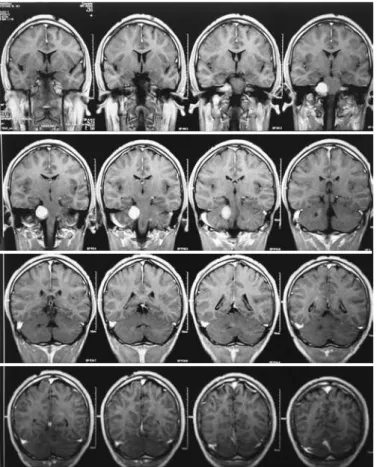Letters to the Editor
1 3 2 Arq Bras Oftalmol. 2016;79(2):132 http://dx.doi.org/10.5935/0004-2749.20160041
Acquired restrictive strabismus
in infancy associated with
neurofibromatosis type 2
Estrabismo restritivo adquirido na infância
associado à neuroibromatose tipo 2
Dear Editors:
We would like to add some new information regarding the pa-tient described in the paper entitled, “Surgical treatment of acquired restrictive strabismus in infancy: case report”, published in Arquivos Brasileiros de Oftamologia in 2009(1). We stated that the diagnosis in
the reported case was unclear despite extensive investigations. After surgical treatment of acquired restrictive strabismus, the child described remained stable with no other symptoms for appro-ximately 7 years. By the age of 14 years, he developed left hand palsy
and skin tumors. One year later, he started experiencing the begin-nings of a hearing loss. Magnetic resonance imaging (MRI) of the brain revea led bilateral tumors indicative of vestibular schwannoma (Figure 1).
Subsequently, the patient was referred to the Neurofibromatosis Reference Center of the Universidade Federal de Minas Gerais for further evaluation. Diagnosis of neurofibromatosis type 2 (NF2) was then established according to MRI demonstrating bilateral vestibular schwannomas associated with cutaneous schwannomas.
NF2 is a dominant, autosomal disease characterized by bilateral vestibular schwannomas with multiple nervous system and skin tumors and is often associated with ocular abnormalities. Although classically considered a disease of adults, the initial signs and symptoms of NF2 may be evident in childhood and often goes unre cognized(2).
Diagnosis is difficult in the majority of cases because of its rarity. Initial manifestations of NF2 differ between children and adults. The first sign of disease severity in patients with early-onset NF2 predomi-nantly comprise ocular presentations and weakness in lower motor neuron extremities as opposed to impairment of the eighth nerve in cases of late disease onset(3).
Approximately 50% of NF2 patients present with strabismus, ty pically associated with tumors and palsies of cranial nerves III, IV, and VI(4). Although restrictive strabismus is not commonly reported in
patients with NF2, it is possible that it was associated with early onset of NF2 in our patient.
Vanessa Waisberg1,
Galton Carvalho Vasconcelos1,
Ana Rosa Pimentel de Figueiredo1,
Débora Marques de Miranda2,
Juliana Ferreira de Souza3,
Luiz Oswaldo Carneiro Rodrigues3
Submitted for publication: September 29, 2015 Accepted for publication: January 23, 2016
1 Departamento de Oftalmologia, Universidade Federal de Minas Gerais, Belo Horizonte, MG, Brazil. 2 Departamento de Pediatria, Universidade Federal de Minas Gerais, Belo Horizonte, MG, Brazil. 3 Departamento de Clinica Médica, Universidade Federal de Minas Gerais, Belo Horizonte, MG,
Brazil.
Funding: No specific financial support was available for this study.
Disclosure of potential conflicts of interest: None of the authors have any potential conflict of interest to disclose.
Corresponding author: Vanessa Waisberg. Av. Brasil, 691 - 4o andar - Belo Horizonte, MG -
30140-000 - Brasil - E-mail: vanessawaisberg@hotmail.com
REFERENCES
1. Damasceno JV, Vasconcelos GC, Figueiredo AR, Almeida HC. [Surgical treatment of acquired restrictive strabismus in infancy: case report]. Arq Bras Oftalmol. 2009;72(1): 119-22. Portuguese.
2. Evans DG, Birch JM, Ramsden RT. Paediatric presentation of type 2 neurofibromatosis. Arch Dis Child. 1999;81(6):496-9.
3. Bosch MM, Boltshauser E, Harpes P, Landau K. Ophthalmologic findings and a long-term course in patients with neurofibromatosis type 2. Am J Ophthalmol. 2006; 141(6):1068-77.
4. Feucht M, Griffiths B, Niemüller I, Haase W, Richard G, Mautner VF. Neurofibromatosis 2 leads to higher incidence of strabismological and neuro-ophthalmological disorders. Acta Ophthalmol. 2008;86(8):882-6.
